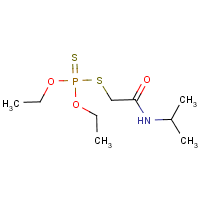Prothoate
Agent Name
Prothoate
CAS Number
2275-18-5
Formula
C9-H20-N-O3-P-S2
Major Category
Pesticides

Synonyms
2-Diethoxyphosphinothioylthio-N-isopropylacetamide; AC 18682; Acetamide, N-isopropyl-2-mercapto-, S-ester with O,O-diethyl phosphorodithioate; American Cyanamid 18682; EI 18682; ENT 24,652; FAC; FAC (pesticide); FAC 20; FAK 40; Fostion; Isopropyl diethyldithiophosphorylacetamide; L 343; N-Monoisopropylamide of O,O-diethyldithiophosphorylacetic acid; O,O-Diethyl S-(2-((1-methylethyl)amino)-2-oxoethyl) phosphorodithioate (9CI); O,O-Diethyl S-(N-isopropylcarbamoylmethyl) dithiophosphate; O,O-Diethyl S-(N-isopropylcarbamoylmethyl) phosphorodithioate; O,O-Diethyl S-isopropylcarbamoylmethyl phosphorodithioate; O,O-Diethyl phosphorodithioate S-ester with N-isopropyl-2-mercaptoacetamide (8CI); O,O-Diethyldithiophosphorylacetic acid, N-monoisopropylamide; Oleofac; Phosphorodithioic acid, O,O-diethyl S-(2-((1-methylethyl)amino)-2-oxoethyl) ester; Phosphorodithioic acid, O,O-diethyl ester, S-ester with N-isopropyl-2-mercaptoacetamide; Prothoat; Protoat (Hungarian); Telefos; Trimethoate; [ChemIDplus] UN2783
Category
Organophosphate Insecticides
Description
Colorless to yellow solid with an odor of camphor; mp = 28.5 deg C; Technical product: Amber to yellow semi-solid; [HSDB]
Sources/Uses
Used as systemic acaricide and insecticide; Likely discontinued for pesticide use worldwide; [HSDB]
Comments
May cause death or permanent injury from exposure during normal use; A cholinesterase inhibitor that may cause nervous system damage and liver injury; [HSDB] Extremely toxic cholinesterase inhibitor; [CAMEO] “The average of two baseline respective cholinesterase activity determinations three days apart, with no exposures to enzyme inhibiting pesticides for at least 30 days, is recommended for each worker prior to exposure to cholinesterase inhibitors because of large inter-individual differences in published baseline values. To be established at least once a year. Removal from workplace exposures is recommended until the cholinesterase activity returns to within 20% of baseline.” [TLVs and BEIs]
Biomedical References
Exposure Assessment
BEI
Acetylcholinesterase activity in red blood cells = 70% of individual's baseline; Butylcholinesterase activity in serum or plasma = 60% of individual's baseline; Sample at end of shift; [TLVs and BEIs]
Vapor Pressure
9.75E-05 mm Hg
Lethal Concentration
LC50 (rat) = 165 mg/m3/4h
Explanatory Notes
The Guide in the Emergency Response Guidebook is for "Organophosphorus pesticide, solid, toxic."
Adverse Effects
Hepatotoxin
Hepatoxic (a) from occupational exposure (secondary effect) or (b) in animal studies or in humans after ingestion
Other Poison
Organophosphate
Diseases, Processes, and Activities Linked to This Agent
Diseases
Occupational diseases associated with exposure to this agent:
Processes
Industrial Processes with risk of exposure: